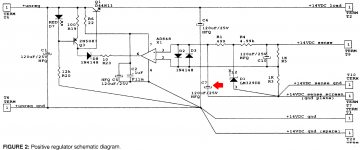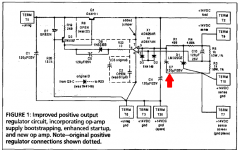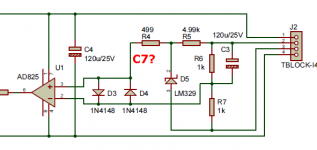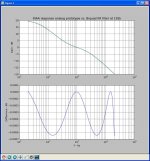that post into English
A Bruno balanced-volume-control thread might be a stimulus to build it.
e.g. : B.O.M. supplement, tips on how to stuff & solder the board etc., possibly a group buy for the components.
My eyes are really bad at short distance, had to print out an enlarged picture to check the board & parts orientation.
(e.g. couldn't read the G sign of D6 on the pcb, and an odd 14 misprint? under C4 <= half a C due to the micro-vias)
Just a thought.
Bit of a shame to let them go to waste, in this particular case (imo, serious for once)
Better ?
Last edited:
A Bruno balanced-volume-control thread might be a stimulus to build it.
e.g. : B.O.M. supplement, tips on how to stuff & solder the board etc., possibly a group buy for the components.
My eyes are really bad at short distance, had to print out an enlarged picture to check the board & parts orientation.
(e.g. couldn't read the G sign of D6 on the pcb, and an odd 14 misprint? under C4 <= half a C due to the micro-vias)
Just a thought.
Bit of a shame to let them go to waste, in this particular case (imo, serious for once)
Better ?
Ahhh yes, VC = volume control. I thought you were taking a ride in the Rolls of the Vice Consul
If there is interest in a group effort I will support that where I can. I understand several are building this preamp, including me.
I think it is time to try my hand on SMD. Bought a really good pincer, and soldered a 8 pin SOIC perfectly! It's easier than it looks.
Thing is I got a large inventory of trough hole parts, now have to stock up on SMD rsistors etc. But they are much cheaper I found out!
Looking at the BOM, there are no exotic parts I can see. Need to decide to use simple 78/79 3-pin regulators, or go for the Hypex ones with remote sensing.
I will see if I can post a larger stuffing guide. Edit: see attached.
jan
Attachments
Last edited:
Ahhh yes, VC
Datasheets of the hpr/hnr12 look impressive (but I already turned a Bruno Ho).
Amusing that the 3 relays are fed by a $50 regulator.
(had one at age ~10 in the RR of Jan v Raak, old/new metal VC in T. At age ~6, I hussled with him about how many items I could get for a fl2.5 Grey bill, one item was an old money coffer. Guy had a MIG23 and a steam locomotive parked in front of his company for years. Zakenman schenkt twee stoomlocomotieven - Digibron.nl Stichting Stoomtrein Tilburg-Turnhout - Wikipedia
Last edited:
I think it is time to try my hand on SMD. Bought a really good pincer, and soldered a 8 pin SOIC perfectly! It's easier than it looks.
Thing is I got a large inventory of trough hole parts, now have to stock up on SMD rsistors etc. But they are much cheaper I found out!
If your SMD resistors are much cheaper than your through hole ones it seems likely you're buying thick film ones. Thin film SMD are often more expensive than through-hole metal film. Whereas for most applications thick film are perfectly adequate, the excess noise of thick film has bitten me on occasion
Datasheets of the hpr/hnr12 look impressive (but I already turned a Bruno Ho).
Amusing that the 3 relays are fed by a $50 regulator.
(had one at age ~10 in the RR of Jan v Raak, old/new metal VC in T. At age ~6, I hussled with him about how many items I could get for a fl2.5 Grey bill, one item was an old money coffer. Guy had a MIG23 and a steam locomotive parked in front of his company for years. Zakenman schenkt twee stoomlocomotieven - Digibron.nl Stichting Stoomtrein Tilburg-Turnhout - Wikipedia
I used to take (NATO) guests on the Limburg stoomtrein when I was working there at HQ AFCENT. Most needed a hand to get off the train at the end of the party, err, trip.
jan
Afraid I have to admit I'm as good as a blank wrt current SMD passive parts.
Sherry & cocktails, hors d'oeuvre & amuses, ay ?
(<= the proper intonation requires a dyslectic & class mate of 40y ago, went to a LOM school first, law school later, runs his own show for the last 15 years in Loenen a/d V. Not bad for a bloke with a huge scar from mouth corner to ear lobe, but rather arrogant then, arrogant now. 'Plek voor de eeuwigheid' | Vechtstroom | dé Weekkrant)
Sherry & cocktails, hors d'oeuvre & amuses, ay ?
(<= the proper intonation requires a dyslectic & class mate of 40y ago, went to a LOM school first, law school later, runs his own show for the last 15 years in Loenen a/d V. Not bad for a bloke with a huge scar from mouth corner to ear lobe, but rather arrogant then, arrogant now. 'Plek voor de eeuwigheid' | Vechtstroom | dé Weekkrant)
Superreg PCB set posted
I finally bit the bullet and layed out a set of superreg boards based on the original 1995 series articles, updated after Walt's 4/2000 article.
These are the successor boards to the ones Jack showed here.
All info is here: The Superregs
Let me know if there's anything I missed or got wrong.
jan
I finally bit the bullet and layed out a set of superreg boards based on the original 1995 series articles, updated after Walt's 4/2000 article.
These are the successor boards to the ones Jack showed here.
All info is here: The Superregs
Let me know if there's anything I missed or got wrong.
jan
I've layed out a revised version, using the original circuit from the 1995 series updated with Walts 4/2000 article in Audio Amateur (all available on Walt's website).
I need to do some small tuning but will then place the Gerbers and stuff on my website for free.
Single board for pos and neg version which can be separated.
Such is the pleasure of a rainy Sunday afternoon
jan
From what I can see, this "new" PCB design is simply the vintage 1995 design, with the op amp rails bootstrapped. No pre-reg (vintage 2000). No shunt opn (vintage 2012 WJ aX interview).
It is a good thing to have the PCBs available for the older design, for sure. But it is also a missed opportunity to not upgrade with other worthy improvements. They might be an option.
Is the Andy Weekes PCB actually available? I clicked on the suggested link and got an error.
Andy Weekes' seller www.at-view.co.uk has been shut down for quite some time, one year maybe.
Let me know if there's anything I missed or got wrong.
Jan, I suspect this was an intentional act rather than a mistake, but capacitor C7 from the original TAA Part3 article, is omitted from your PCB and your schematic. I imagined there might have been discussion about C7 on this thread, and indeed I did search for "C7" but found nothing.
Schematic snippets below for comparison.
-Mark
Attachments
Teaser
I'm preparing an article for the next issue on biquad digital filters for RIAA, crossovers, equalization, etc. Thanks to the last two issues of Elektor, I have been turned on to Python as a free development platform. Now it looks like I can provide a free software tool for filter development. Here is a screen shot teaser, +- .00035 dB do that with analog.
I'm preparing an article for the next issue on biquad digital filters for RIAA, crossovers, equalization, etc. Thanks to the last two issues of Elektor, I have been turned on to Python as a free development platform. Now it looks like I can provide a free software tool for filter development. Here is a screen shot teaser, +- .00035 dB do that with analog.
Attachments
Andy Weekes' seller www.at-view.co.uk has been shut down for quite some time, one year maybe.
Well spotted. Glad I raised the issue with Jan. So we do not even have ALW PCB design available anymore. Another thing, europe (and the rest of the world) needs its own supply. Expensive buying from the united states for 2 PCBs etc. SMD is still quite tricky for some of us...
Last edited:
Schematic snippets below for comparison.
-Mark
Mark,
Actually I recall there was, and am trying to recollect from memory here - it seemed to affect the sound quality for some reason.
1, It may well be that if the noise of the reference diode was at very high frequencies (inaudible anyway) then adding an RC filter may attenuate this noise downwards into the audioband or near it.
An FFT or looking on a scope for the freq. of the ref. diode noise might be a clue.
2, Their is leakage errors introduced by the capacitor here. This is well known and I have seen buffered references using additional op amps with much smaller RC networks using films/ceramics to deal with this issue.
I once seen a snippet of a schematic of a WJ design that bootstrapped the capacitors in this location to reduce the leakage errors. Low leakage capacitors will help. However I never seen the full article or explanation, or it may be in one of WJs books. Personally, I never liked the capacitor over the feedback resistors. This is to keep noise gain down by I think a factor of 3. But you can run it half wave - or lower source Zin for the main output follower.
3, Maybe the capacitor through its leakage errors when using the remote sensing can allow spurri in possibly audible without attenuation of any form?
I do not know being honest.
Possibly a worthwhile tweak is do what Doug Self does with his CCS in his power amps and split R into 2 for the main led CCS (that drives the output follower) in these designs and add a capacitor at the midpoint. A long gate J310 would help also. I was thinking this, because if your look at the PSRR/loop gain of the AD825 it is poor at LF albeit better in many other areas like slew rate/settling time and so on. It all depends on what input voltage you have and what you can burn etc.
Only thing I dislike in Jans new design is the lack of the follower or shunt arrangement after the op amp and before the output follower. There may well be a stability issue here however. That was the genius of the modded '95 design and WJ's EDN article.
Best Regards
Kevin
Last edited:
- Home
- General Interest
- Everything Else
- New Linear Audio publication!



